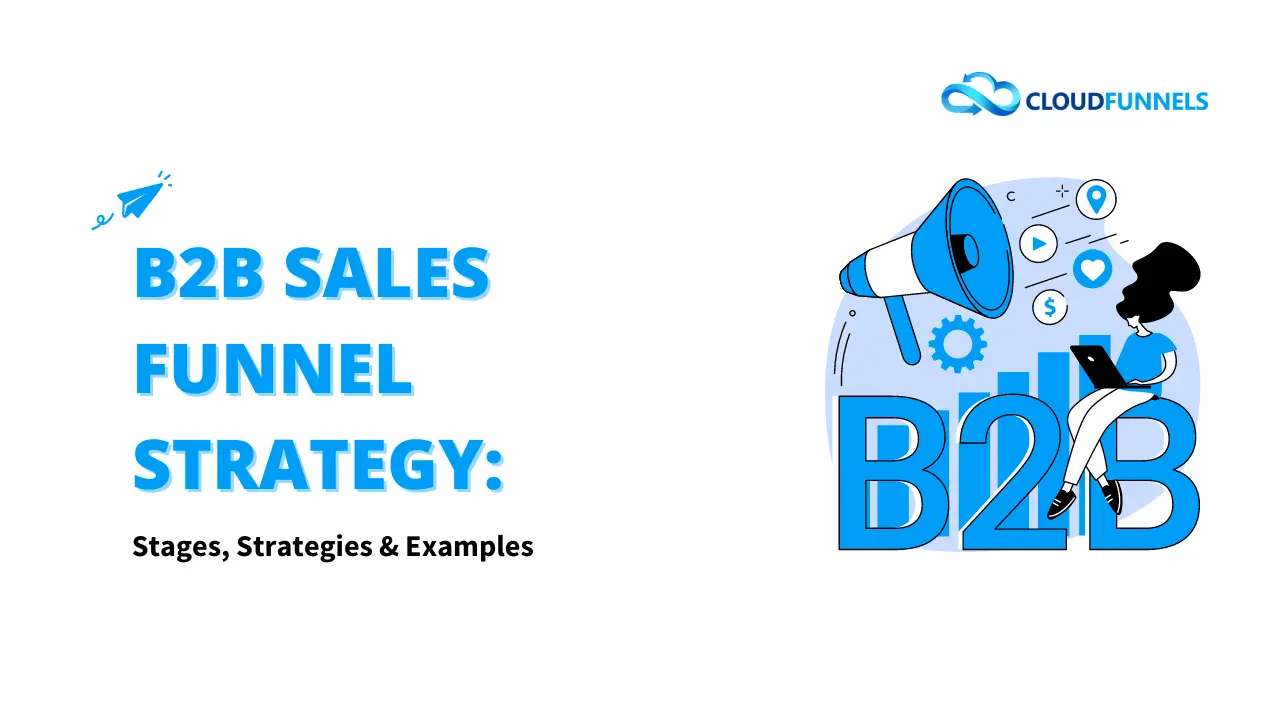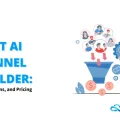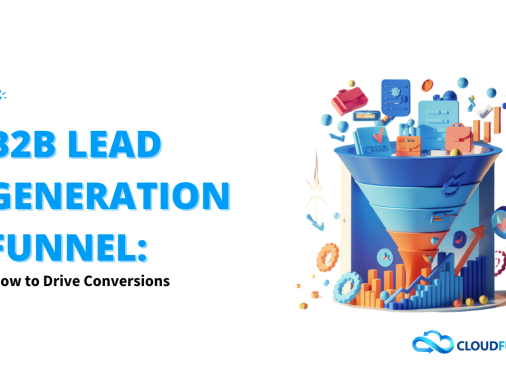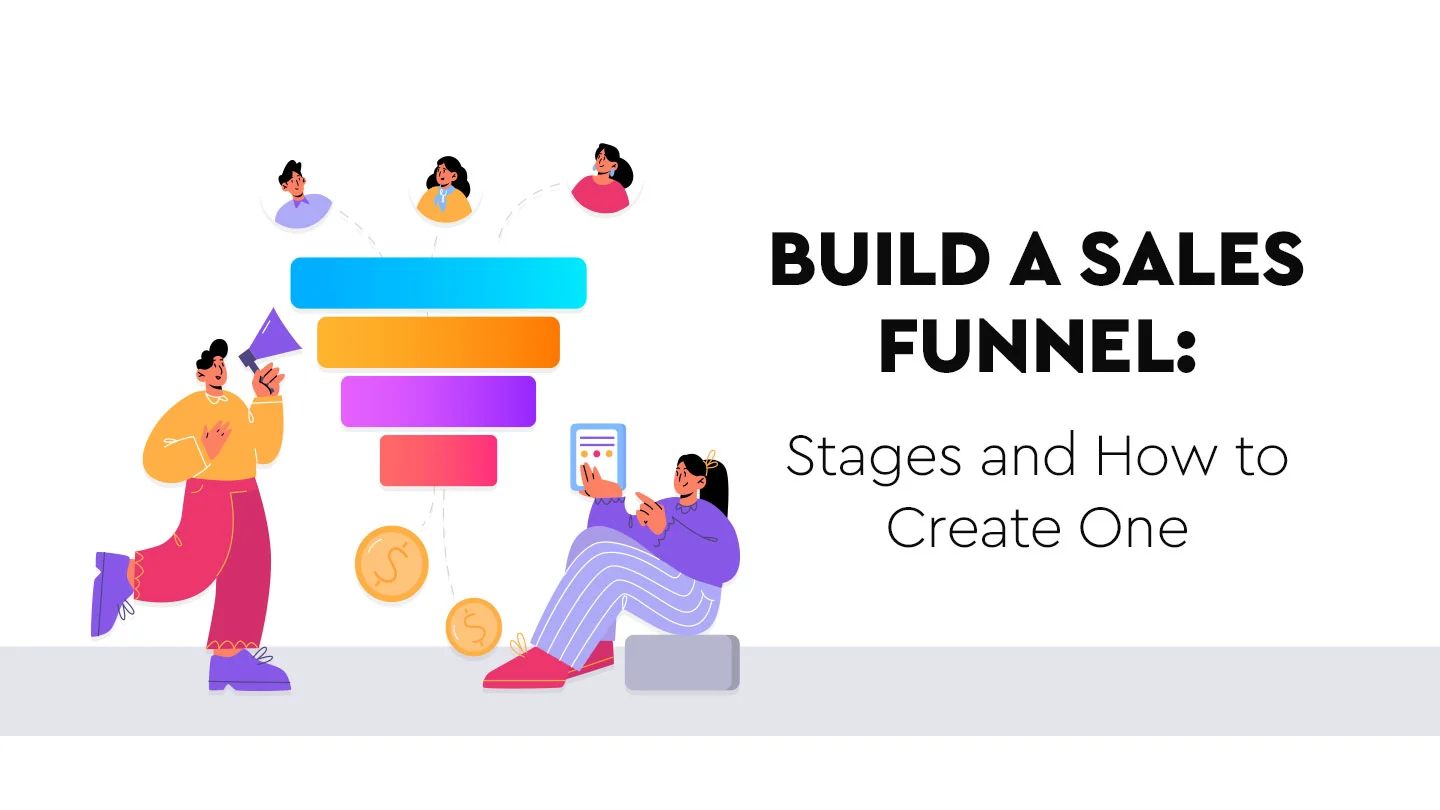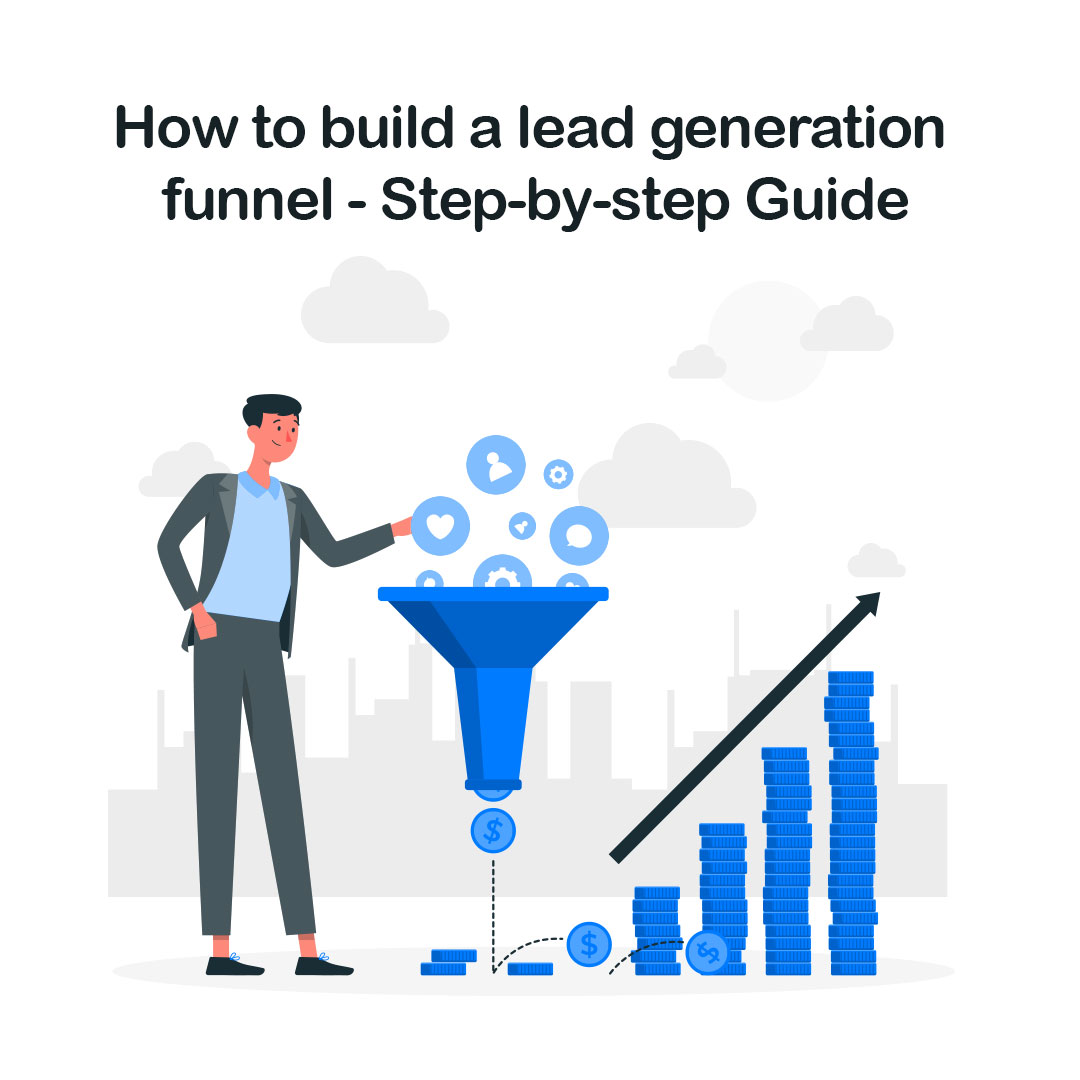As a marketer, you constantly seek ways to connect with new customers while increasing sales with existing ones. But how do you make that happen?
Navigating the B2B sales funnel strategy is complex but the B2B sales funnel helps you guide potential customers through the buying process, from initial awareness to making a purchase decision. B2B marketing strategies need to be effective and thoughtful in guiding leads from initial interest to a signed contract.
In this article, you’ll dive into what a B2B sales funnel is, the stages involved, effective strategies, and real-world examples. You’ll also explain how to use it effectively and provide examples to help illustrate it.
Start with, What is a B2B sales funnel?
A B2B sales funnel is a step-by-step process that guides potential clients from the first stage of awareness to making a purchase.B2B sales funnels are crucial for structuring lead nurturing and converting prospects into clients. The funnel makes sure of marketing and sales efforts, ensuring the whole organization focuses on converting leads into loyal customers.
Therefore, the funnel helps direct sales and marketing efforts, allowing them to adjust their strategies to address the needs of potential customers at each stage. Let us begin by discussing B2B versus B2C and its stages.
B2B Sales Funnel vs. B2C Sales Funnel
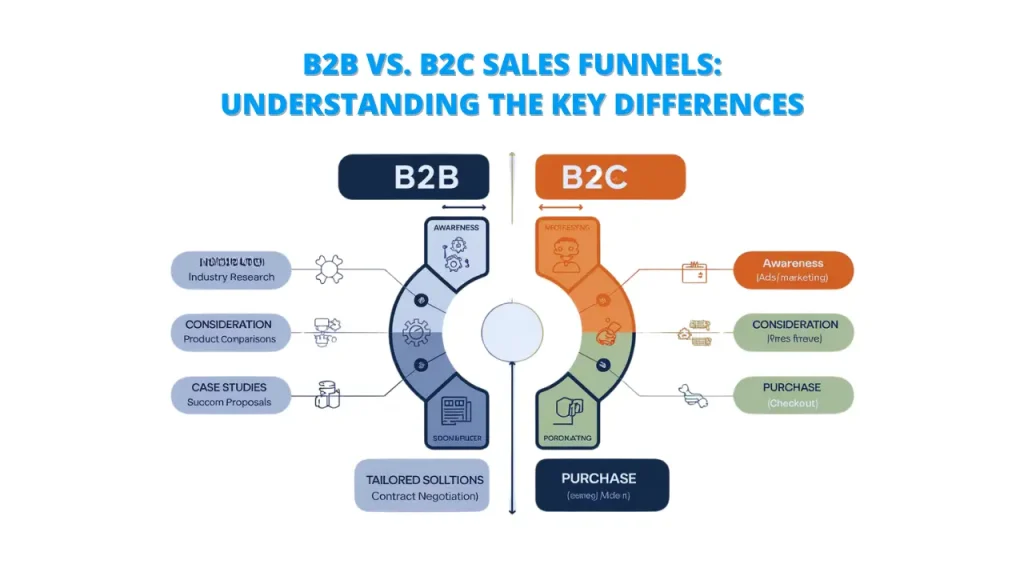
Before exploring the B2B sales funnel strategy and stages, it’s important to discuss the key differences between B2B and B2C funnels. While they share a similar structure, B2B funnels are more complex due to longer sales cycles and multiple decision-makers.
In B2C funnels, the focus is on individual consumers and quick buying decisions, with shorter stages like awareness to purchase. But B2B funnels, however, require more detailed stages, including case studies, product comparisons, and tailored solutions.
Stages in the B2B Sales Funnel
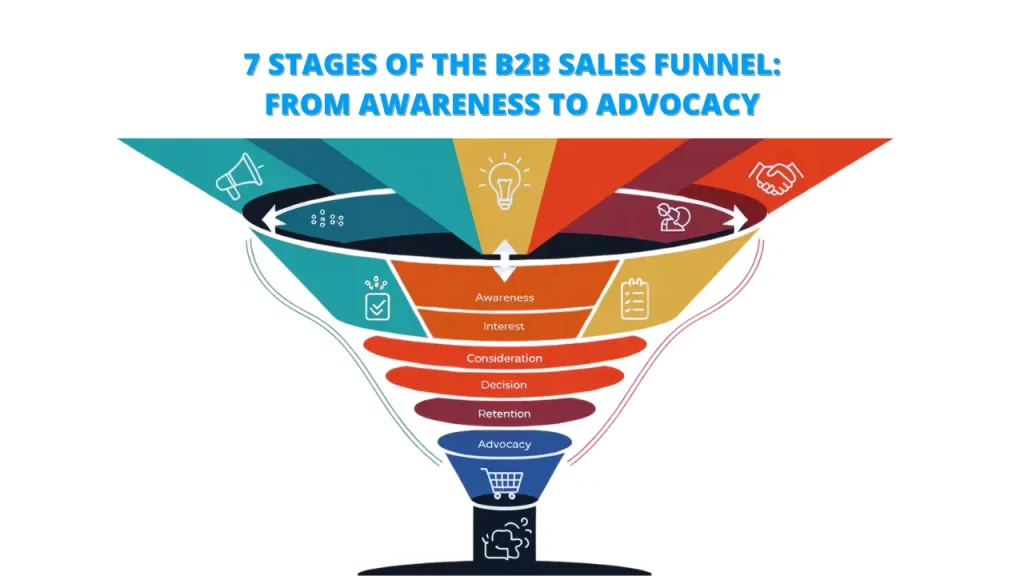
Most B2B sales funnels follow these seven stages, each crucial for directing potential customers smoothly through the sales cycle.
Knowing these stages will help you refine your B2B sales funnel strategy and boost conversions in your pipelines.
1. Awareness Stage: Getting Attention in a Crowded Market.
The awareness stage is about making your brand visible to potential customers who may not even know they have a problem you can solve. This stage helps us attract attention and generate interest. To excel in this stage:
- Create educational blogs, infographics, and videos.
- Leverage social media to increase reach and engagement.
- Use SEO best practices to boost search visibility.
Additionally, you can also focus on targeted lead generation to attract the right audience and tailor your approach to their needs.
2. Interest Stage: Growing Curiosity and Engagement
In the interest stage, after capturing attention in the first stage, now you will focus on building interest in customers by:
- Offering valuable resources like whitepapers, e-books, and webinars.
- Use personalized email content to match prospects’ interests.
- Share your expertise by attending industry events and publishing your insights.
3. Consideration Stage: Guiding Prospects Through Evaluation
In the consideration stage, as customers begin to evaluate their options, your role is to provide them with tools and content to help them make good decisions. Effective strategies include:
- Provide detailed product demos highlighting your unique value.
- Send free trials or consultations for hands-on experience.
- Share case studies and success stories with real results.
4. Decision Stage: Converting Prospects into Customers
The decision stage is important for turning interested buyers into paying customers. To boost this stage:
- Create urgent and compelling calls-to-action (CTAs).
- Offer tailored sales proposals that meet customer needs.
- Provide clear details on pricing, implementation, and support.
5. Purchase Stage: Ensuring a Smooth Transaction
Once a consumer decides to buy, in this purchase stage you need to make the process as seamless as possible for the customer.
- You can simplify your checkout procedure to reduce confusion.
- Offer multiple payment options for them.
- Clearly outlines the next steps and implementation timelines.
6. Retention Stage: Supporting Long-Term Relationships
Retention is key to long-term success. In the retention stage, focus on keeping your customers happy and engaged:
- To ensure consumer success, build a solid onboarding method.
- Check in often to resolve problems and find sale chances.
- Offer top-notch customer service across a variety of channels.
7. Advocacy Stage: Turning consumers into brand advocates
In the last advocacy stage, satisfied customers can be your strongest marketing tool. Advocacy helps generate word-of-mouth and attract new leads. To foster advocacy:
- Build a loyalty program that rewards repeat purchases and referrals.
- Encourage customers to share their positive experiences.
- Connect with customers on social media and showcase their experience.
Strategies for Successful B2B Sales Funnel Management
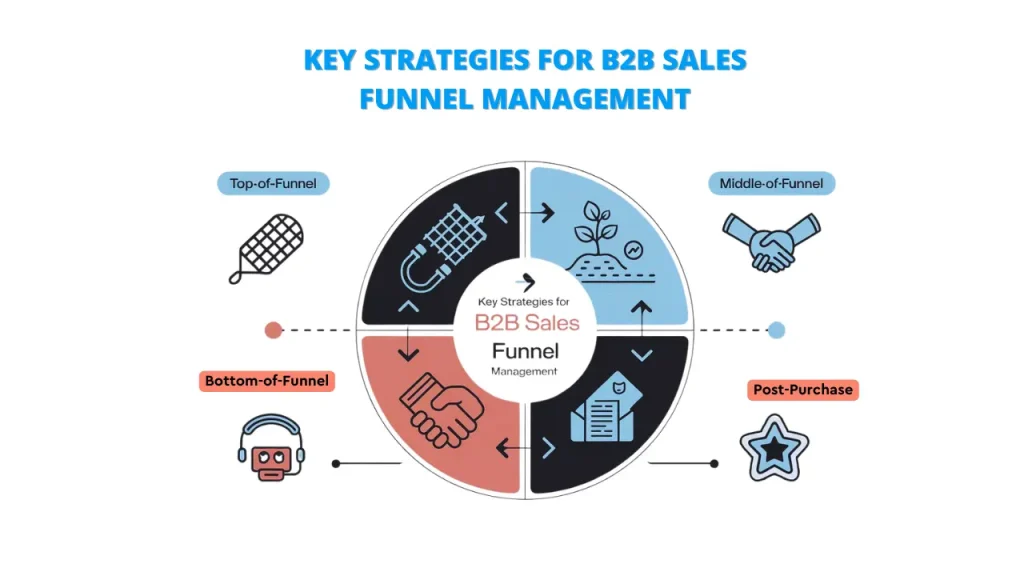
1. Top-of-Funnel Strategies: Casting a wide net
At the top-of-the-funnel (TOFU), you can attract a regular stream of qualified leads:
- Build an in-depth content marketing plan that speaks to different buyer personas.
- Boost search engine visibility for your website by improving its content.
- Use social media to connect with the target audience and share useful insights.
2. Middle-of-Funnel Strategies: Nurturing Leads to Maturity
Middle of Funnel (MOFU) leads us to keep main prospects engaged and moving through the funnel by:
- Run advanced email marketing campaigns with personalized content.
- Use CRM tools for B2B to monitor interactions and customize your approach for each consumer.
- Provide valuable resources like webinars and whitepapers that tackle specific challenges.
3. Bottom-of-Funnel Strategies: Sealing the Deal
Bottom of Funnel (BOFU) leads are ready to buy. So now you need to convert interested prospects into customers with these tactics:
- Coordinate sales and marketing teams to maintain a consistent message during the buyer’s journey.
- Create personalized offers that address each prospect’s specific problems.
- Use effective closing ideas, like time-limited deals or bundled packages.
4. Post-Purchase Strategies: Cultivating Customer Success
Maximize customer lifetime value by:
- Setting up a strong onboarding process to help customers fully benefit from your solution.
- Creating cross-selling and upselling strategies based on customer needs and behavior.
- Offers excellent support to resolve issues and keep customers satisfied.
5. Using Technology: Improving Your Funnel with AI and Automation
These technologies help in managing leads, automating follow-ups, and making sure that no potential customer slips through the cracks. You can boost funnel efficiency by:
- Using AI for round-the-clock customer support and B2B lead qualification.
- Employing marketing automation in B2B tools to send personalized content at scale.
- Utilizing CRM systems to monitor and analyze customer interactions across all channels.
Executing B2B Sales Funnel Strategy: A Beginner’s Guide to Success
To successfully run a B2B sales funnel, begin by identifying your target audience and creating clear buyer profiles.To well execute a B2B sales funnel strategy, start by defining your target audience and creating detailed buyer personas. Next, map out your customer journey in B2B and identify the key touchpoints. Develop a content strategy that addresses each stage of the funnel to engage prospects at every step.
Now choose the right tools to support your funnel analytics strategy and implement tracking systems to measure performance. Finally, continuously test and optimize your funnel based on the insights gathered from your data.
Case Studies: B2B Sales Funnel Strategies That Achieved Rapid Growth
Case Study 1: Tech Solutions Inc.
Tech Solutions Inc. implemented a strong content marketing strategy and used marketing automation in B2B. This approach led to a 150% increase in qualified leads and a 30% rise in conversion rates within six months.
Case Study 2: Global Manufacturing Co.
By utilizing personalized email campaigns and a streamlined CRM system, Global Manufacturing Co. shortened its sales cycle by 40% and improved customer retention by 25%.
Conclusion
As you are at the end of the blog, a well-structured B2B sales funnel is essential for converting leads into customers and making long-term relationships. By understanding each stage and implementing the strategies, businesses can optimize their funnels for better growth.
For those looking to streamline and enhance their sales pipeline management, CloudFunnels is an excellent tool to consider. This tool allows you to create landing pages, funnels, lead pages, and business websites—all without any coding skills. It handles your entire sales process, from customer awareness and acquisition to follow-up.
If you’re serious about improving your B2B sales funnel strategy, CloudFunnels provides all the assistance you need to succeed. Evaluate your current funnel, identify improvement areas, and apply the strategies discussed above. With continued effort, you’ll be on your way to B2B sales success.
FAQs About B2B Sales Funnel Strategies That Drive Explosive Growth
Q. What is a B2B sales funnel?
Ans. A B2B sales funnel is a model that maps out the journey a customer takes from first learning about your product or service to making a purchase and beyond.
Q. How does a B2B sales funnel work?
Ans. It guides potential customers through various stages, from awareness to purchase and beyond.
Q. What are the stages of a B2B sales funnel?
Ans. A typical B2B sales funnel includes stages like awareness, interest, consideration, decision, purchase, retention, and advocacy.
Q. How can you optimize the B2B sales funnel?
Ans. B2B sales funnel optimization is to create targeted content for each stage, use marketing automation in B2B, align sales and marketing efforts, and regularly analyze and refine your approach.
Q. What tools are best for managing a B2B sales funnel?
Ans. Common tools include CRM systems like CloudFunnels or HubSpot, marketing automation platforms like Salesforce, and analytics tools like Google Analytics.

